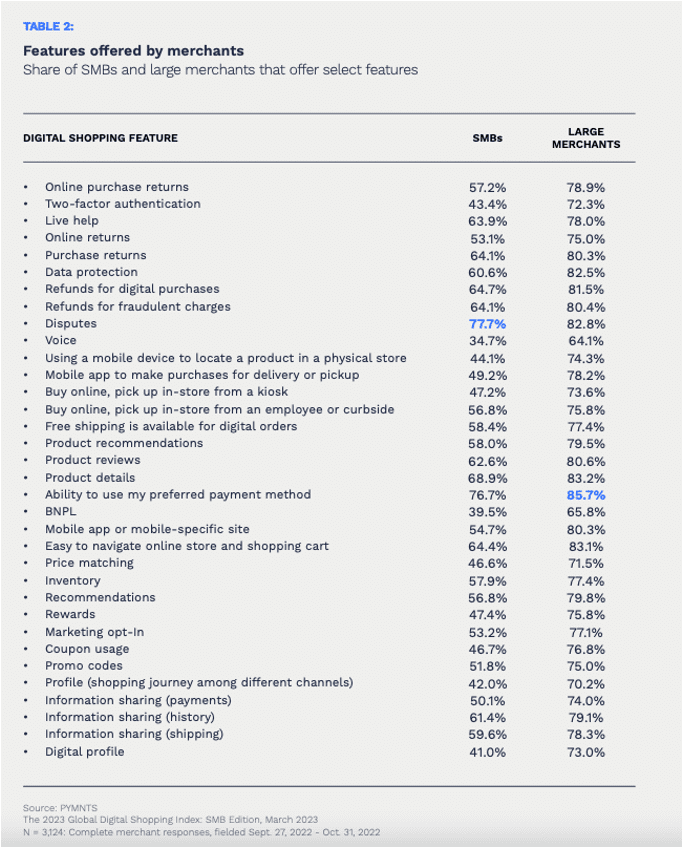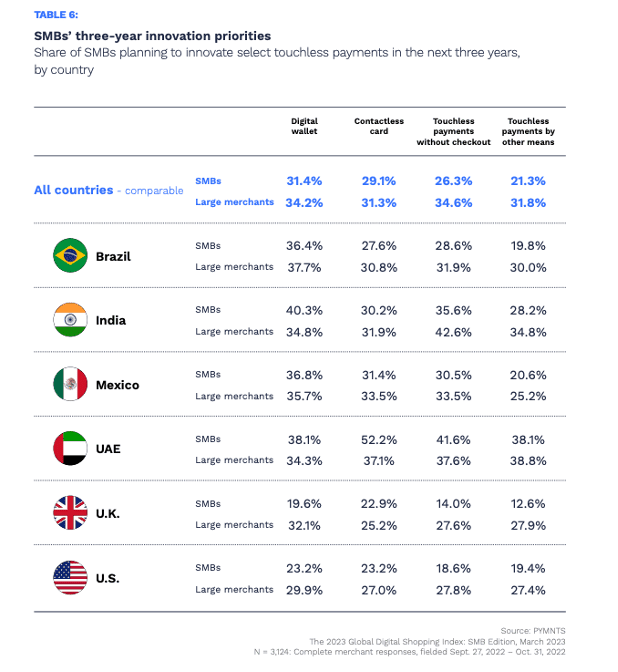Small Retailers Fall Behind Enterprises in Digital Features and Shopping Experiences

According to new research, small and medium-sized businesses (SMBs) must embrace the shift to digital features more deeply if they hope to stay relevant and competitive.

Based on findings from “The 2023 Global Digital Shopping Index: SMB Edition” (GDSI SMB), a PYMNTS and Cybersource collaboration surveying over 13,300 consumers and over 3,100 merchants across Brazil, India, Mexico, the United Arab Emirates, the United Kingdom, and the United States, consumers say they are not finding the digital features they value when shopping SMBs.
Offering seven fewer features on average than larger competitors, the spread between the two classes of retailers is evident in the average GDSI scores, with SMBs coming in at 91, and larger merchants delivering an above-average score of 105 when averaged out.
Part of the problem is an awareness gap about digital features that creates frustration on both sides of the counter, as, for example, 69% of SMBs provide product details online, but only 57% of shoppers know it, equating to a 20% knowledge gap and reduced usage, which in turn can drive SMB customers to larger competitors that have made digital features prominent.
Illustrating the dangers of letting this situation persist, the research finds that 55% of SMB shoppers globally fall under the “Digital Enthusiast” persona.
As the study states, Digital Enthusiasts are “chiefly interested in digital shopping features that can help make their shopping journeys simpler and more efficient, such as product details that shoppers can find online and sites that are easy to navigate. Winning the business of these shoppers would require SMBs to deliver these efficiency-boosting features to streamline their customers’ shopping journeys.”
Use It Or Lose It
Much of the feature gap for SMBs comes in the form of smartphone-powered shopping and payments experiences that larger merchants have prioritized since the start of the pandemic digital shift and are now part of the expected flow.
For example, SMBs are 37% less likely than larger businesses to offer mobile apps for delivery or pickup, and 44% less likely to offer cross-channel digital profiles, enabling consumers to access stored product and payment preferences as well as shipping information allowing them to shop and pay via smartphone apps no matter where shopping journeys start and end.
We found that even common digital features like mobile-optimized websites are missing in 32% of SMB shopping journeys in the six nations studied, which consumers in 2023 won’t tolerate.

Regarding payment options, in some of the most evolved economies including the U.S. and the U.K., 22% of U.S. SMBs and 25% of those in the U.K. have yet to embrace digital wallet acceptance despite the rising usage of this payment method.
Compare that to countries like India and the UAE, where 96% and 95% of all large merchants accept digital wallets, respectively, and the issue is thrown into stark contrast. Where SMBs are focusing more attention and upgrades is contactless card payments, with 29% of SMBs planning to add contactless cards in the next three years, and 26% anticipating touchless checkout innovations.
This is vitally important as the U.S. edition of the GDSI found that contactless card usage in brick-and-mortar stores in the U.S. surged 567% in 2022 alone.
For these reasons, SMBs surveyed are planning to get more aggressive in adding digital features and will build on slight leads they have in curbside and in-store pickup options, which are gaining favor among consumers when obtaining orders placed online.
We found that 34% of SMB shoppers in five countries plus India, which is new to the GDSI, “picked up their most recent purchases in-store in 2022. Just 22% of large merchant eCommerce customers picked up their most recent purchases in-store.”
To capitalize on this, 27% of SMBs surveyed said they will add curbside or pickup options in the next three years, “and 23% plan to adopt in-store kiosks where eCommerce shoppers can acquire their purchases. Similarly, 26% of SMBs intend to adopt mobile capabilities that allow shoppers to verify whether the item they want is in stock before they decide to travel to the brick-and-mortar store to purchase it.”
Get the study: The 2023 Global Digital Shopping Index: SMB Edition

